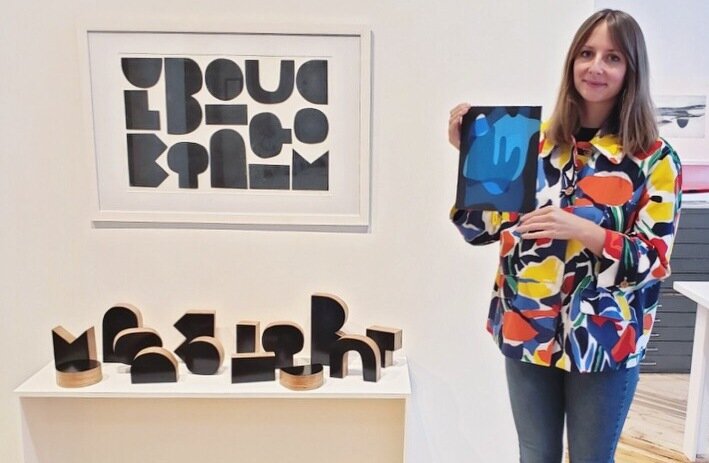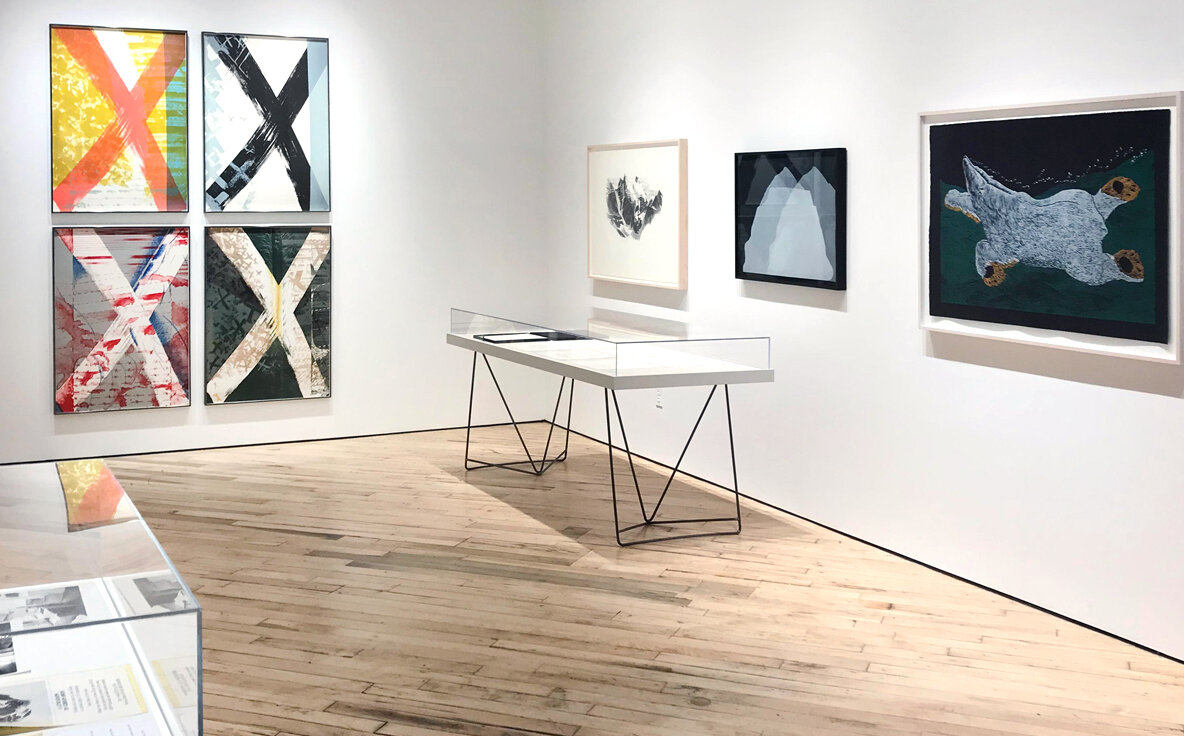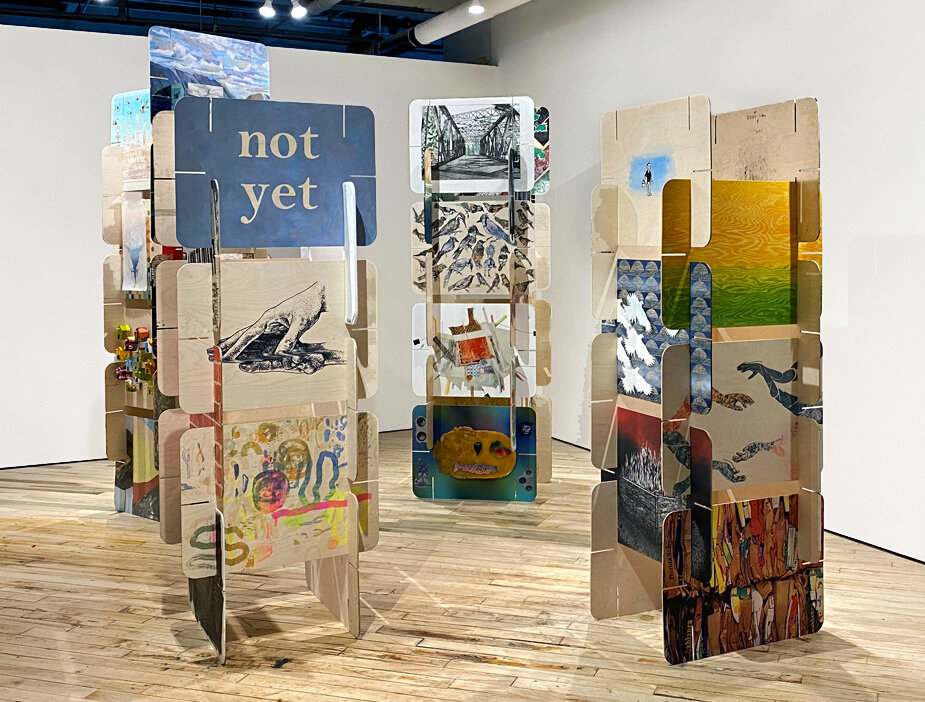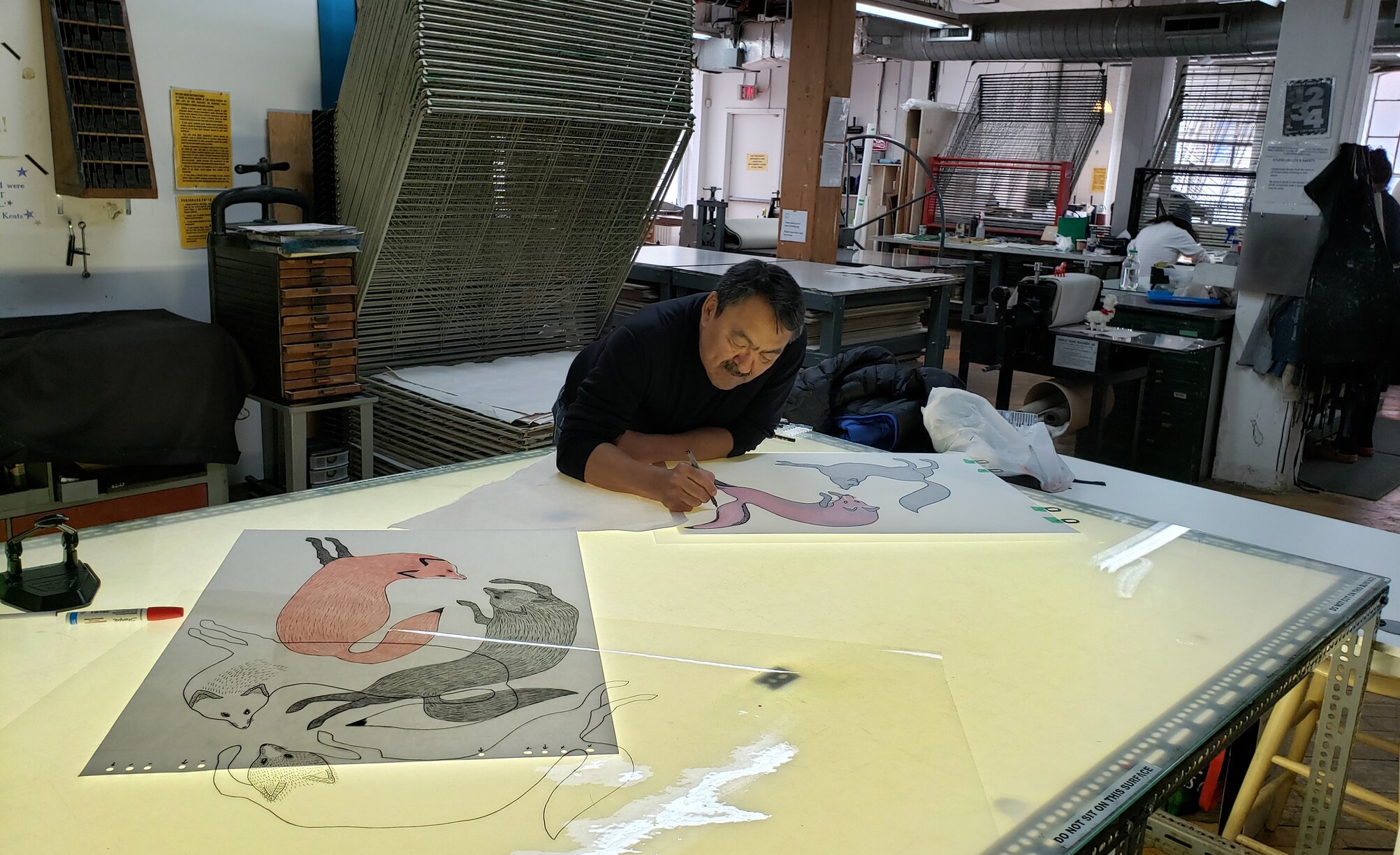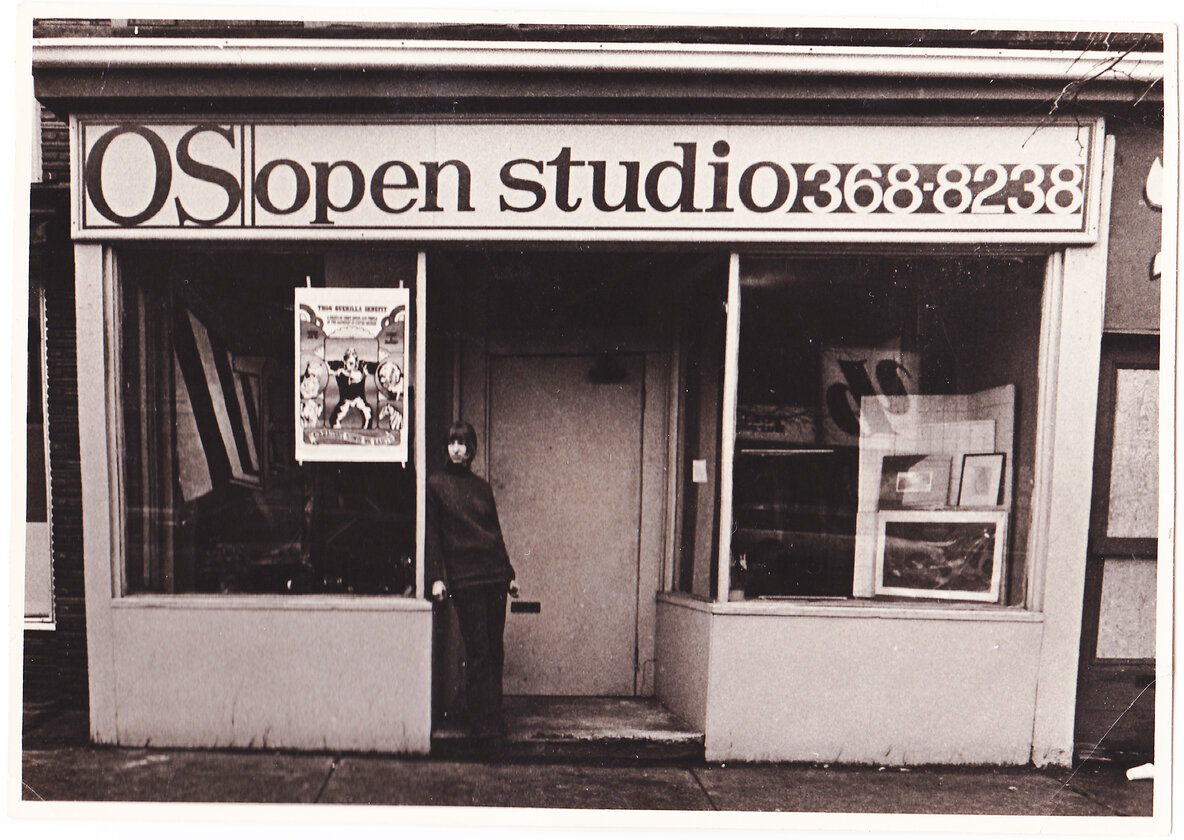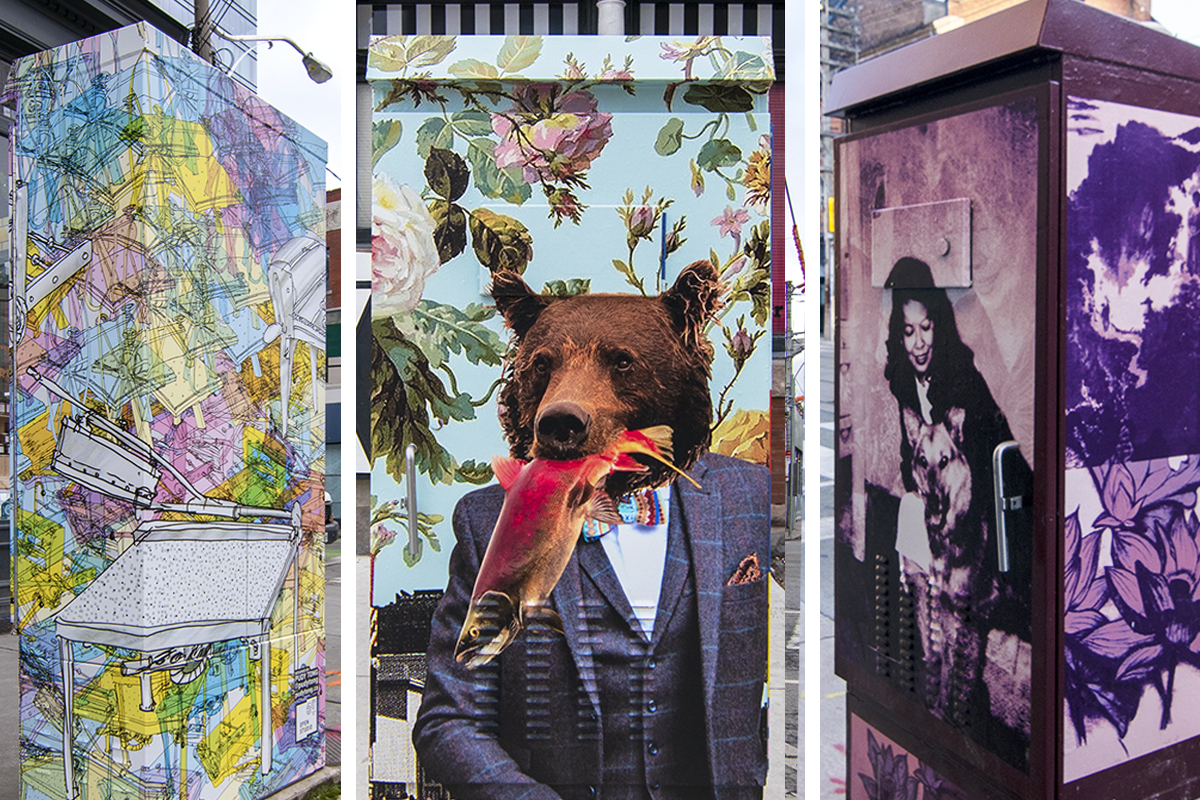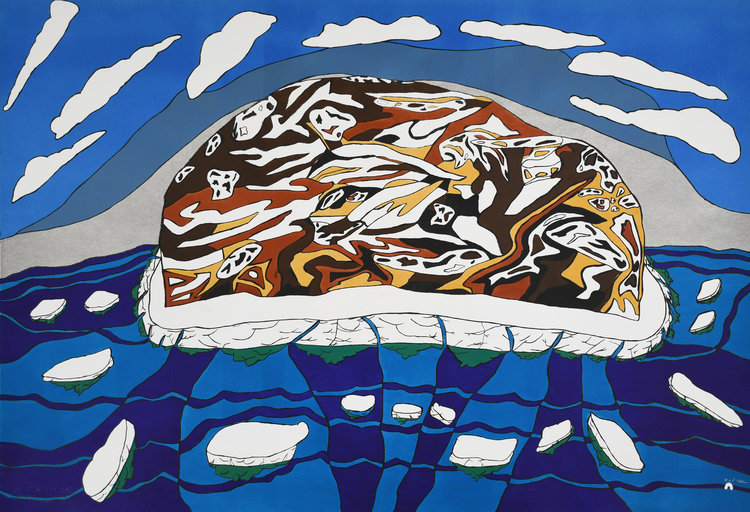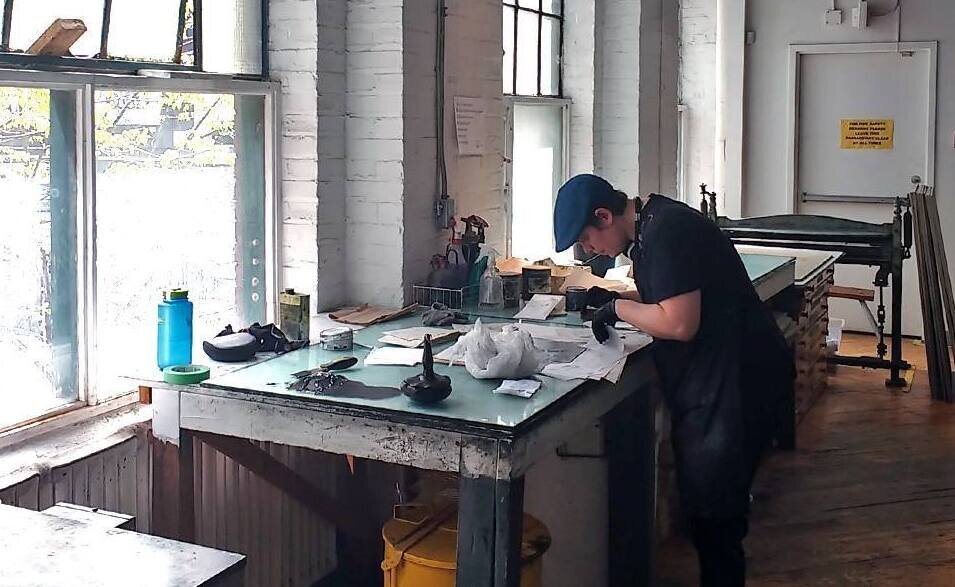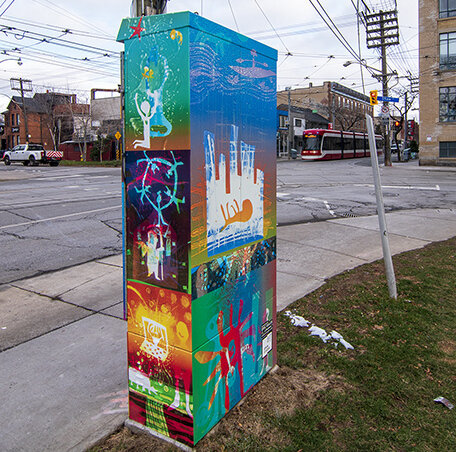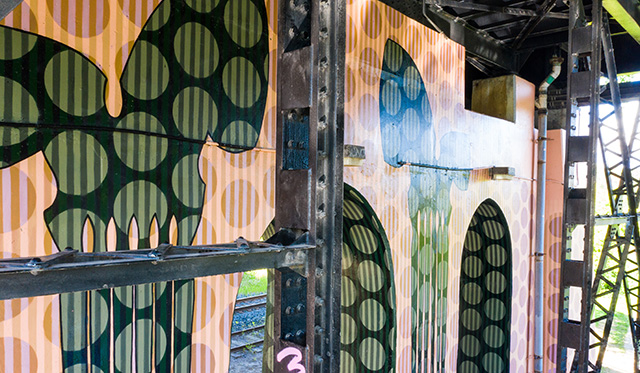Interview with Sales & Archive Manager Rebecca Travis (RT) and Technical Director Anna Gaby-Trotz (AG-T) of Open Studio by Olivia Mariko Hsuen-Ferris (OMH-F).
The interview took place in January 2021 on the occasion of Open Studio’s 50th anniversary in 2020 and their recent project with StreetARToronto.
Open Studio’s Sales and Archive Manager, Rebecca Travis, holding a subscription print by Sameer Farooq and standing in front of Tom Lecuyer’s Feature Wall installation, Shape Garden 2019. Photo: Laura Bydlowska
OMH-F: Congratulations to all at Open Studio on this milestone anniversary of 50 years supporting printmaking in Toronto! I know your recent partnership with StreetARToronto is in celebration of this anniversary, what else did you have in the works for this occasion?
RT: Thank you! Our 50th anniversary was in 2020 and obviously it was not quite the year we had anticipated. Our main aim was to push printmaking in different directions and acknowledge Open Studio’s past while celebrating the future. We opened the anniversary year with an archive exhibition, which showed prints by some of the artists who have worked at the studio over the years including Rita Letendre, Michael Snow, Tim Pitsiulak, General Idea, and Vera Frenkel, amongst many others.
Installation view of the Archive Exhibition, PRESS RECORD: Prints from the Open Studio Archive, January 10 – February 8, 2020, with works by (L-R): Vera Frenkel, Gordon Smith, Sameer Farooq, Tim Pitsiulak and Micah Lexier (vitrine).
Our current exhibition Murmuration celebrates Open Studio’s current community and takes print to a sculptural realm with artists printing onto wooden boards that are slotted together to create three-dimensional structures. We have also just opened another public art exhibition in collaboration with Lake Effect Projects, which sees prints by four artists enlarged to billboard scale at the Jack Layton Ferry Terminal, and continues into the summer. In the fall of 2020 we hosted our first ever online fundraiser called Future Proof, which celebrated Open Studio’s golden anniversary, and helped us in securing our future too.
Installation view of Murmuration, an Open Studio group exhibition celebrating 50 years, November 20, 2020 – March 6, 2021
AG-T: Yes, we had lots of events planned for our 50th celebration. One of the big events in the studio was hosting our annual Inuit Artist Creative Residency in partnership with The West Baffin Eskimo Cooperative and Dorset Fine Arts. In February 2020, artist Quvianaqtuk Pudlat worked with collaborative printers Nick Shick and Jessica Palmer to create two beautiful screen prints.
Quvianaqtuk Pudlat preparing drawings to screenprint at Open Studio
OMH-F: In your partnership with StreetARToronto, I noticed that one traffic signal control box is located by Queen and Peter (today in front of Peter Pan Bistro and facing a MEC!) near Open Studio’s original address at 310 Queen St. 50 years ago. How else do the locations of the sixteen works connect with the long legacy of Open Studio?
RT: The locations map a route connecting to sites of artist-run activity past and present, using Open Studio’s original location as a starting point. A lot has changed geographically for Toronto’s art scene in the 50 years Open Studio has existed.
AG-T: One of the things this route marks is the migration of artists and Artist Run Centres out of the downtown core. As rents went up, these people and places were pushed further West into the Junction. It really highlights the significance of Open Studio being able to stay in downtown Toronto and offer artists access to such an amazing studio and gallery space.
Open Studio Co-Founder Barbara Hall standing in the doorway of Open Studio’s first location, 310 Queen Street West, c.1971
OMH-F: With such a large-scale and permanent public project with the City of Toronto (StreetARToronto), what kind of criteria did you use to curate the featured artists and their works?
RT: We juried for the twelve Open Studio artist designs with the city’s leads on the StreetART project, Jason Campbell and Catherine Campbell, and an artist with connections to Open Studio. As a jury, we took into consideration the city’s mandate for diversity, visual boldness, and the adaptability of the design to the traffic box structure. We also considered how the box designs might deter graffiti and their connection to narratives around Toronto. When working out where different artist designs would be positioned in terms of the boxes available to us, consideration was taken for how the design would relate or provide apt juxtaposition to their site.
AG-T: The jury also looked at representing artists from many different stages of their artistic practice. This is what makes Open Studio so incredible to work in. Artists at the beginning of their careers can work beside artists who have really established practices. We also took into consideration highlighting the various print techniques that we have at Open Studio.
Detail of traffic signal control cabinets by (L – R): Pudy Tong, Meggan Winsley and Brenda Joy Lem
OMH-F: On your website, you mention the printmaking connection between the North and South in reference to the four artists from WBEC Studios in Kinngait, Nunavut, featured in the StreetARToronto partnership. Could you speak to this connection as well as Open Studio’s connection with WBEC Studios?
AG-T: Open Studio has had a creative partnership with WBEC for over 30 years. Over the last five years we have reignited an Inuit Artist Creative Residency with Tim Pitsiulak being our inaugural artist. The residency was so successful that we were able to invite Quvianaqtuk Pudlat to join us in 2020. We are planning a virtual residency with Ooloosie Saila in 2021, and hope to have her join us in Toronto as soon as it’s safe to do so. I’ve also been fortunate enough to travel to Kinngait three times, and am working with WBEC to set up a sustainable etching program for the artists in Kinngait.
RT: Three of the four artists from Cape Dorset involved in the StreetART project, including Ooloosie Saila, were also included in a curated exhibition called Where She Lives that was due to take place in our galleries just as the pandemic hit. The show ended up taking place online, but it was great to be able to also include a piece by each of the artists in the StreetART project so that the work could be encountered in a much more physical way.
Ooloosie Saila Silaksiaq, Beautiful Day, 2019, lithograph, Edition of 50, 30” x 44”
OMH-F: I love this idea of taking the private realm of printmaking to the outer realm of the public. What is the significance of this outward shift?
RT: Open Studio has so many amazing artists that work within its walls, but printmaking is very labour intensive and so much of what happens in the studio is usually hidden from public view. We have two gallery spaces, but they only allow for a certain amount of engagement, and our audience are usually intentional visitors who already know our space. One of the aims of the 50th anniversary programming was to put printmaking front and centre in unexpected ways. The StreetART project allows for encounters with printmaking in unusual contexts within the wider urban environment. Hopefully it means more people will connect with printmaking, Open Studio, and the artists who have work in the project.
Open Studio’s Technical Director, Anna Gaby-Trotz, working in the studio. Photo: Laura Bydlowska
OMH-F: The City of Toronto’s plan to invest in street art is a creative solution to a municipal gripe with vandalism as well as an investment in the local art community. In addition to being the channel to a symbiotic relationship, what does the medium of the traffic signal control box mean to Open Studio or to the genre of printmaking?
RT: The boxes presented a challenge in terms of a three-dimensional object as opposed to the traditional supports of paper or textile. They also required the translation of an analogue medium into a digital wrap, which retained a sense of its hand-created mark-making, but with the durability of a public art piece.
AG-T: I think it also takes some of the preciousness out of the medium. Through the translation of print into the large-scale wraps, there is a shift that takes place. These pieces become a part of the urban landscape in a way that a print on paper or a gallery wall cannot. It opens up space for chance encounters with art—waiting for a street car, or walking out for groceries.
Eric Euler’s box at Queen Street West and Shaw Street. Image from the artist’s Instagram
OMH-F: As we usher in the City of Toronto’s new ten-year Public Art Strategy, I was wondering if you see anything unique in Toronto’s approach to public art compared with other cities?
RT: It’s great to see the city formally commit to give focus to public art. Projects like StreetARToronto are already making public art a lot more accessible by becoming part of the ongoing urban fabric, as opposed to just one-off large-scale projects connected to new developments. There’s also some great programming happening in the Don Valley River Park and at The Bentway. The city has a lot of its current public art mapped now, which is great—there’s a lot of them already here when you know where to look. This new ten-year strategy will hopefully continue to add a more diverse array of voices to the art in place across the city.
Beth Stuart, Reube (V. Stepanova and M. Vionnet), 2019, public mural commission, Don River Valley Park, Toronto
OMH-F: As lockdowns continue in increasing intensities, Open Studio’s partnership with StreetARToronto is a lovely solitary activity where people can get out and get active with safety. Was this something you considered when curating the works or a happy consequence of the time?
RT: The fact that so many galleries have had to close their doors at this time certainly gives new importance to having art outside in the public realm, which isn’t bound by the same restrictions, but the timing of the pandemic was definitely not expected. We’ll take it as a silver lining of the project’s timing—I think we all need a few of those! We hope that people will enjoy the project and follow the route to see all the boxes. There is an online map to follow and we hope that it will give people a chance to both get fresh air and engage with the project at the same time.
AG-T: Yes, definitely the silver lining. The lockdown happened just as the project had been juried. There were a few moments when we weren’t sure it would happen—there was a lot of uncertainty of what The City would be offering. I’m really happy that The City of Toronto has continued to support artists and the staff who create the space for artists to work and live in Toronto. This was such a vital project for our artists at this time. I had several people say working on this project was a real light for them during a very challenging time!
Images are courtesy of Open Studio
*Exhibition information: StreetARToronto Partnership, December 1, 2020 – January 1, 2025. Various locations in the city, please view the online map.

